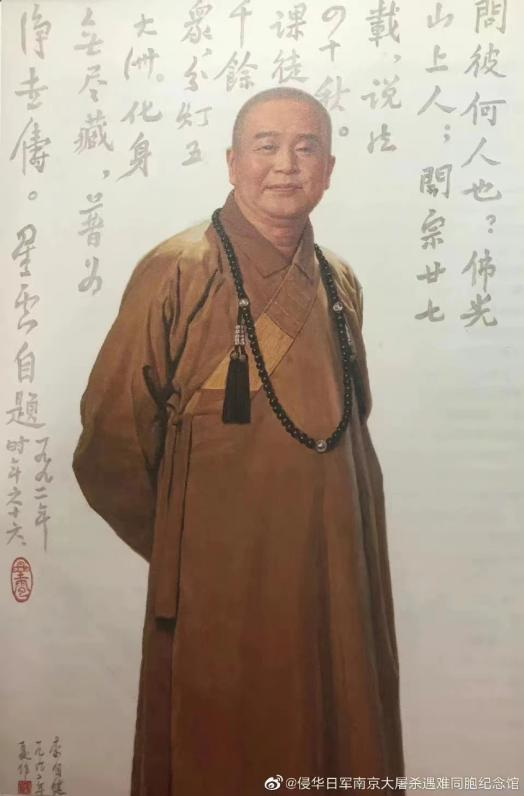Venerable Master Hsing Yun, a Witness to the Nanjing Massacre, Died
On the afternoon of February 5, 2023, Venerable Master Hsing Yun, founder of the Fo Guang Shan Buddhist order in Taiwan, China, passed away at the age of 96.

A portrait of Venerable Master Hsing Yun, created by Li Zijian in 1992
Venerable Master Hsing Yun, formerly known as Li Guoshen, was born in Jiangdu County, East China’s Jiangsu Province, in 1927. At the end of 1937 when the Japanese troops invaded Nanjing, his father, Li Chengbao was running a business in Nanjing. After the city was captured, he lost contact with his father. The next year, his mother took him to Nanjing trying to find his father. There he witnessed the horror of the Nanjing Massacre. “I saw corpses floating down the river, their head down and feet up. The corpses were everywhere. The blood was even mixed with the leaves and mud at the bottom of the river. I also saw corpses piling up on the street, their chest already eaten by dogs. The list can go on and on.” Venerable Master Hsing Yun once described the Nanjing Massacre as a “living hell”. He didn’t find his father in the end and became a monk at the Qixia Temple in Nanjing.
During his lifetime, Venerable Master Hsing Yun always hoped to keep the history of the Nanjing Massacre. He asked travel artist Li Zijian to create a cautionary painting so that more people in the world could learn about the tragedy in human history. The paining was named “Slaughter·Rebirth·Buddha — The Nanjing Massacre”.

Slaughter·Rebirth·Buddha — The Nanjing Massacre
The oil painting is 3.2 meters wide and 2.1 meters high. As its names suggests, the painting consists of three parts, “slaughter”, “rebirth” and “Buddha”. The left part, “slaughter”, shows two Japanese soldiers standing with a smile and one of them rubbing blood off the sword after a beheading contest; the middle part, “rebirth”, shows a child crying on a pile of dead bodies, including that of his mother; the right part, “Buddha”, depicts a monk carrying a dead old man. The main part of the painting is the mountain of corpses. The shape of the mountain is an indication of the irrefutable evidence of the crime committed by the Japanese troops in the Nanjing Massacre. Behind the corpses is the running Yangtze River.
In 1992, a global non-profit tour kicked off for the oil painting. So far, it has been exhibited in more than 30 countries and regions across six continents, including Germany, Britain, France, Australia, South Africa, Brazil, Canada, Singapore, Malaysia, and Thailand.
On December 13, 2020, Venerable Master Hsing Yun and Li Zijian donated the historic masterpiece to the Memorial Hall. The oil painting was included in national class-I cultural relics on the Chinese People's War of Resistance Against Japanese Aggression in 2015 and is now on permanent display as part of the Nanjing Massacre Exhibit at the Memorial Hall.

